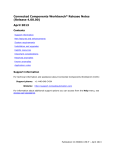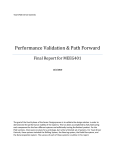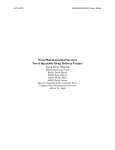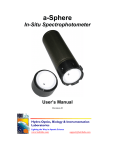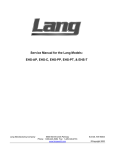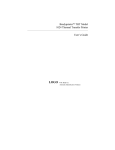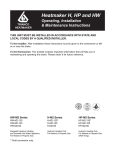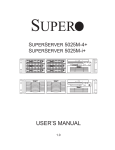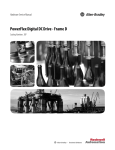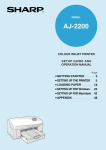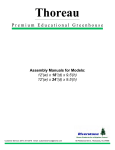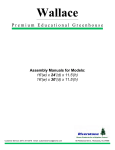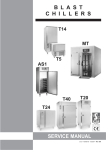Download 03-2012 Report - University of Delaware
Transcript
Final Design Report Filter Fabric Material Life Cycle Testing Unit Team W. L. Gore Michael Marando Robert McGrath Michael Pfeiffer ToniLynn Yavorski Sponsor W. L. Gore Advisor Dr. Jennifer Buckley, PhD MEEG401: Senior Design Department of Mechanical Engineering University of Delaware, Newark, DE Submitted: 12/12/2012 Table of Contents INTRODUCTION …………...……………………………………………………………..…...1 Background and Significance …...………………………………………………………1 Project Scope ...…………………………………………………………………………...1 Needs, Wants & Constraints………………………………………………………….......1 Design Metrics…………………………………………………………………………….2 CONCEPT GENERATION & SELECTION………………………………………………….3 Benchmarking…………………………………………………………………………….3 Preliminary Concepts & Selection ...…………………………………………………….3 FINAL DESIGN …………………………………………………………………………………5 Overview ………………………………………………………………………………….5 Design Details ……………………………………………………………………………5 User Instructions …………………………………………………………………….......9 Cost Analysis …………………………………………………………………………......9 DESIGN VALIDATION ………………………………………………………………………10 Failure Analysis ………………………………………………………………………...10 Testing …………………………………………………………………………………..10 Validation Results………………………………………………………………….……11 CONCLUSIONS……………………………………………………………………………......12 Design Evaluation ………………………………………………………………………12 Deliverables ……………………………………………………………………....……..12 Path Forward …………………………………………………………………………...12 APPENDICES ………………………………………………………………………………....14 Appendix A: Drawing Package .....………...……………...………………………….15 Appendix B: Force Calculations ...………...…………...…………………………….44 Appendix C: User Manual ...………………………………………………………….45 Appendix D: Bill of Materials ……...…..…………………………………………….56 Appendix E: Path Forward Technical Information ………..…………...……….…60 INTRODUCTION Background and Significance W. L. Gore is well known for the fabrics they manufacture for a variety of applications. One of these families of fabrics is used in industrial air filtration. In this application, open-ended cylindrical bags made of the fabric filter are hung in cages. Dirty air is forced through the sides and bottom and clean air exits through the top causing the outside of these filter bags to become caked with particulates. To improve airflow, compressed air is fired axially down the inside of the bags to dislodge the particulates. W. L. Gore has previously designed a unit to test the life cycle of the filter fabric material in a destructive test, which simulates accelerated wear due to firing compressed air. However, this previous design does not operate as required nor does it include desired functionalities. It is also not user friendly and has raised safety concerns. Project Scope W. L. Gore has requested that the senior design team redesign the filter fabric material life cycle testing unit to their specifications. This will allow for W. L. Gore employees to conduct accelerated life cycle tests of existing filter fabrics, and use these results as a benchmark for the development of new filter fabrics. Needs, Wants & Constraints The team constructed a prioritized list of needs, wants and constraints and a list of metrics for evaluation. These were presented to the sponsor and approved after several iterations. The prioritized needs, wants and constraints are as follows: Needs & Wants (highest to lowest priority): ! Noise Reduction: The previous design operated above the limits of OSHA regulations and was a nuisance to operators. The new design should be quieter and meet OSHA regulations. ! System Stability: For safety, the new design should have no significant movement during operation due to the forces exerted from the firing of compressed air. ! Control System: The new design will have a revised control system with components from the old unit and new components to allow for desired functionalities. A new control system is required in order to integrate an alarm system, as requested by the sponsor. ! Cost: The sponsor requested that the redesigned unit cost less than $10,000 to develop. ! Heat Tolerance: The testing chamber and all internal components must be able to withstand the temperature of a heated test, which could be as high as 120°C. ! Fabric Fixture Redesign: The redesigned fabric fixture should expose a circular area of 9 in2 as requested by the sponsor. ! Visibility: The testing chamber is to allow a clear, ergonomic and lighted view of the surfaces of the mounted fabric specimen through two windows. ! Ease of Cleaning: The inside of the redesigned testing unit chamber is to have more rounded corners and edges and fewer crevices than the previous design. The unit should be able to be cleaned quickly and efficiently with a vacuum and/or a damp rag. 1 ! Portability and Operation: The unit is to require no more than one individual to transport and setup for operation and will have wheels for transportation. ! Durability: Major components of the system should not require maintenance before 1,000,000 cycles. ! Specimen Heating: The ability to heat a fabric specimen to 120°C is requested. ! Specimen Quantity: The ability of the testing unit to accommodate two fabric specimens simultaneously is requested. Constraints: 1. Air Supply: Limited by Gore’s central compressed air equipment: 600 gallon tank, 75 hp screw, 105 psi, 1 inch air headers, and 100-200 ft of hose before testing unit. 2. Exhaust Vacuum: Testing chamber will have an air hose compatible with Gore’s industrial vacuum, with a 2.75” diameter port, to remove air-born particles. Design Metrics Metric Operation Noise Displacement Alarm System Target < 85dB < 0.5” 30 seconds Cost Heat Tolerance Fabric Fixture < $10,000 130° C Circular area of 9 in2 2 Sides 1 psi Visibility Pressure Control Ease of Cleaning Portability and Operation Durability < 5 minutes 1 Person 1,000,000 cycles Specimen Heating 120° C Specimen Quantity 2 Description Must meet OSHA regulations For safety, cannot move during operation For safety, shuts down test in the event of pneumatic failure or chamber opening Requested by W. L. Gore Tolerant above maximum operating test temperature To be more comparable to industrial applications Ergonomic and clear visibility of illuminated specimen Unit fires when tank pressurizes to within 1 psi of set value, for test reliability Time required to clean inside of chamber Only one person required for transit and operation Number of firing cycles before any major maintenance is needed Achieve desired specimen surface temperature Accommodate two fabric specimens simultaneously Table 1: Prioritized list of metrics and target values 2 CONCEPT GENERATION & SELECTION Benchmarking In the previous testing unit designed by W. L. Gore, air was taken from the central compressed air distribution system in the production plant and brought to the unit by a hose with a quickrelease header. The air passed through a manual shut off valve followed by a moisture removal unit. The airline split to fill two air tanks to specified pressures as controlled by manual regulators. The air from the right tank traveled by hose to the right side of the testing chamber, where it passed through a heater, followed by a thermocouple to monitor the temperature. It then passed through a nozzle, held in place by a nozzle bracket, to fire a constant flow of heated air at the right side of the specimen. The air from the left tank traveled by hose to the left side of the testing chamber, where it was fired cyclically using a solenoid valve at the left side of the specimen. The fabric specimen was secured between two frames, which left a square area exposed, and the fabric fixture slid into upright fixture brackets. One of these frames had vertical metal bars, which simulated the cage in a filter bag. The fixture brackets and nozzle brackets could be repositioned along the tracks inside the testing chamber. Figure 1: Front view of previous design Figure 2: Interior of testing chamber The previous testing chamber was constructed of wood, had a single window on the front, and had multiple cabinet latches to lock it. The interior was lined with low-density foam to dampen sound. There was a sensor on the chamber to ensure that the unit operated only when the chamber was closed, but it was not operational. A programmable logic controller (PLC) controlled the firing of the solenoid valve and the heater; however, the heater and thermocouple were not wired properly for temperature control. The testing chamber, control unit, and pneumatic system were all mounted onto a cart with pneumatic wheels. Preliminary Concepts & Selection This project is a redesign of the old testing unit, which calls for the general design to remain the same but for the majority of components to be new and upgraded. The component options are presented and selected with justification below: 3 ! ! ! ! ! ! ! ! ! ! Air Shut-Off Valve: For safety, a valve is needed to close off the air supply to the unit. The available options were automated ball valves and manual ball valves. An electrically actuated ball valve was chosen, as it allows for programmed control of the air supply. Moisture Separator: Removing moisture from the air prolongs the life of the unit. The choice was between reusing the old unit’s moisture separator, which could be restored to full functionality with a maintenance kit, or finding a different model with the same specifications. It was deemed most cost effective and sensible to reuse the old moisture separator and purchase the maintenance kit. Pressure Regulators: To control the pressure of the tanks, air pressure regulators are needed. The available options were manual, digital, and digital with input and feedback with PLC. The final option was chosen as it allows for program control and monitoring of the pressures with high accuracy. Tanks: The capacity of the tanks did not significantly influence the functionality of the design so the choice had to be based on other factors. The chosen tanks were the same capacity as the previous unit’s tanks. However, the shape was chosen to be shorter in length than the previous tanks in order to better fit on the cart; necessary port sizes were also taken into consideration Solenoid Valves: There are a variety of specifications available for solenoid valves: NPT inlet and outlet sizes, orientation of inlet and outlet (180° or 90°), normally closed or open, medium and ambient temperature tolerance, activation voltage (120V or 24V, AC or DC). The specifications chosen were 1” NPT for ideal air flow, 180° orientation for simplicity of piping, normally closed for safety, tolerant of at least 120°C, and 24V DC for simplicity of electrical wiring. Air Heater: A new air heater was needed, as the old unit’s was broken. After product research it was determined the old unit’s model is the only option found for this application’s specifications. Thermocouple and Sleeve: To monitor the air temperature a thermocouple and sleeve are required. It was determined that the old unit’s thermocouple (Omega, Type K) and sleeve should be utilized as it is fully functional and intended for the selected air heater model. Testing Chamber: The testing chamber could be constructed using wood, sheet metal, or plastic. The decision was to have a 1/8” aluminum chamber lid and bottom fabricated by a machine shop as it was recommended by specialists in acoustic insulation, will be temperature tolerant, and will shorten the total assembly time. Sound Insulation: There is a variety of sound dampening foams, but few that are heat tolerant. After researching foams the only option that was heat tolerant to specification was melamine foam. The thickest option of 2” with a Mylar facing for easy cleaning was chosen. Windows: The window options were dictated by available transparent and heat tolerant materials, which narrowed down the choices to glasses or transparent polymers. Glass is 4 ! ! ! ! temperature resistant but it is heavy and not effective as a sound dampener. Clear plastics, like Plexiglass, Lexan©, and polycarbonate are better sound dampeners. Doubled sided abrasion resistant 0.5” polycarbonate was chosen for the windows, which will be double-paned for additional acoustic insulation. Lighting: The sponsor requested that the testing chamber have interior lights. The options for lights were LEDs, incandescent bulbs, halogen bulbs, and fluorescent bulbs. After research it was determined that LEDs and fluorescent bulbs will not operate properly under high temperatures and halogen lights get too hot. Incandescent bulbs with heat tolerant ceramic sockets were chosen. Chamber Interior Components: The choice was between reusing single specimen components from the old unit while adding compatible new components to accommodate two specimens, or fabricating all new components. It was deemed ideal to fabricate all new components to more easily allow for the desired configuration and accommodation of two specimens. Control System: The control system options were reusing the entire control system, scavenging the PLC and some components, or completely rebuild the control system. The sponsor requested a new PLC and Human Machine Interface (HMI), as the old PLC was not deemed user friendly. Components of the old system, namely the control box, power converter, terminal blocks and relays were reused. The new PLC will also allow for the requested alarm system functionalities in the event of chamber opening or pressure loss. Cart: Researched carts come in many shapes and styles, ranging from widths of 24” to 36” and lengths of 18” to 60”. Cart heights were relatively consistent but a variety of handle types allow for different ergonomics. A cart 30” wide x 48” long x 36” tall with locking wheels and floor brake was chosen for expected stability due to its wide base, locks, and dimensional accommodation of the testing chamber. FINAL DESIGN Overview In the testing chamber of the redesigned unit, one or two fabric specimens can be mounted for life cycle testing. The fabric specimen(s) can be subject to one of two tests; a test that includes cyclically fired air from one or both sides or a test that includes constant heated air from one side and cyclically fired air from the other. The exact test to be run and relevant parameters such as air temperature, fired air pressure and sequence, and total cycles of test are set in the control system using the HMI. The control system will have an alarm system programmed that pauses testing in the events of pressure loss or testing chamber lid opening. Design Details In the redesign of the testing unit, air is taken from the central compressed air distribution system in Gore’s production plant through a hose with a quick release header. The air passes through an 5 electrically actuated ball valve followed by a moisture removal unit. The airline then splits to supply two digital regulators with digital feedback that will control and monitor the pressures of the two air tanks in conjunction with the PLC. The 10-gallon capacity tanks, the same size tanks in the old unit, were deemed sufficient, due to the tank size not influencing the initial and maximum force of the fired air. The air in the tanks is to be released by solenoid valves and directed through two sets of nozzles mounted inside the testing chamber. The nozzles to be fired should be set with the 3-way ball valves. Between the nozzles, the fixture brackets will hold the fabric fixtures so that a circular area of the filter material is exposed to the air fired orthogonally at the surface from both sides. One of the frames has vertical bars to replicate the air filter cage. See Appendix A for drawing package. The testing chamber is composed of 1/8” aluminum sheet metal with an interior lining of sound dampening Mylar coated 2” melamine foam. The testing chamber is dimensioned to accommodate a nozzle-to-fabric distance from 1” up to 8.5” on one side if desired, as determined by force calculations (See Appendix B), and 2” of foam with at least an inch of extra space for additional foam if needed. To provide clear visibility of the specimens, the front and back of the testing chamber lid are sloped with double-pane, abrasion resistant polycarbonate windows. Two incandescent bulbs mounted inside the lid will provide illumination and can be turned on or off via the HMI. The testing chamber has an exhaust duct to remove air born particles, which is compatible with the industrial vacuum at Gore’s production plant. All components of the testing unit are mounted on an industrial cart, which has dimensions chosen to accommodate the testing chamber, with locking wheels and a floor brake. Figure 3: The redesigned testing unit 6 Figure 4: Piping & Instrumentation Diagram Figure 5: Back view of unit showing pneumatic components 7 Figure 6: Interior of testing chamber Figure 7: The fabric fixtures are composed of two frames, one with vertical bars, and four screws (left). The fixture brackets hold the fabric fixtures in place (right). An Allen-Bradley Micro830 PLC was selected and configured to provide the correct number of inputs and outputs (I/O), both analog and digital, for the control system. I/O was determined based off solutions to all other needs and wants. The control system allows for the operator to select either a heated or a non-heated test, and input testing parameters such as pressure, valve opening times, total number of cycles, and time between cyclic firings. The operator can stop the test when desired, and resume until total cycle count is reached, or reset the counter to zero and begin a new test. If a pressure loss occurs in the system, and the valves do not fire for 30 seconds, the system will go into an alarm mode, venting the tanks and pausing the test. If the lid of the testing chamber is opened, the valves will not fire until the lid is closed. 8 Figure 8: Control System User Instructions Prior to operation, the exhaust duct is inserted into the industrial vacuum, the unit is plugged into a 120V AC power source, and the plant air supply line quick release is attached to the air inlet. The nozzle brackets and fabric fixtures are adjusted to the desired positions. The fabric specimen(s) are secured into the fabric fixture(s) and slid into the fixture brackets. The 3-way ball valves must be opened or closed in accordance with the nozzle set(s) to be used for the life cycle test. At least one nozzle set should be open for any test. The testing chamber is closed and the latches are engaged. See Appendix C for complete users manual. Cost Analysis The final design costs a total of $9,214.59 of the $10,000 budget. The cost of each item is displayed in the Bill of Materials in Appendix D. The most expensive components in descending order were the two digital pressure regulators ($1,500), the fabricated aluminum testing chamber ($1,168), the HMI ($687), the two solenoid valves ($668), and the sound insulation ($588). Every other component’s price was under $500. The components are divided into five categories based on where they fit into the design. The pneumatic items had the largest cost, as they were the most important features of the design. The testing chamber is the second most expensive. It required the most individual parts but almost half of its cost came from the fabricated testing chamber. Categories Cost Testing Chamber $2,360 Pneumatic Items $3,686 Control System $1,607 Interior Fixtures $990 Miscellaneous $572 Total $9,215 Table 2: Cost of each project category and total cost 9 DESIGN VALIDATION Failure Analysis The most likely design failure is in the wiring and programming of the control system, due to the lack of expertise in the team. In wiring the components there is the risk of damaging internal circuitry, which will be mitigated by seeking outside help and intensive testing. In programming the control system there is the risk of the program being dysfunctional and damaging components as a result, which will be addressed by intensive testing. One such component that could be damaged is the heater, which will blow out if the solenoid valve is closed off while heater is operational. Programming the control unit to supply air to the heater until it has cooled will mitigate this risk. Another possible failure is the overheating of the solenoid valves due to the heater. This risk has been lessened by selecting solenoid valves with high enough ambient and media temperature specifications and placing a PTFE fitting between the solenoid and heater to reduce heat conduction. The unit is not equipped to handle a power outage, so an uninterruptable power supply should be provided, however this issue was identified too late in the design process to fully address. Testing ! Preparation time: The sponsor requested that the specimen mounting preparation was timed. Specimen mounting consists of placing the fabric specimen between the two brackets, tightening all four screws and placing in the testing fixture. An individual with a single precut piece of fabric, set of frames and screws, and Allen wrench was timed by a second person with a stopwatch. The result was 44 seconds, which implies that the preparation is simple and easy. ! Operation noise: While the unit was operating at 50 psi, a decibel meter was positioned at a 3 ft distance to measure the maximum sound intensity the unit produces over multiple valve firings. The measured value was 110 dB, which means that the design is operating above OSHA regulations. ! Displacement: A displacement dial indicator was positioned against the side of the cart to measure the side-to-side displacement. A video was taken of the dial reading while the testing unit fired at 30 psi. The measured maximum displacement was 0.001” when unit fired, meaning that the unit is very stable. ! Alarm for Pressure Loss: To simulate air pressure loss, the air supply pressure was lowered below the set pressure of the tanks at the start of a test. The time until the testing unit activated the alarm response was timed at 30 second. This observed response time confirms that the program properly signals an alarm when the tanks have not filled to the set pressure in 30 seconds. ! Alarm for Lid Opening: To test the alarm for the opening of the lid, the testing chamber lid was unlatched and lifted until the closure sensor disengaged. The testing unit’s response was closely observed. The solenoid valves’ instantaneous ceasing to fire confirms that the alarm operates as desired. 10 ! ! ! ! ! ! Pressure Control: For life cycle test reliability, the solenoid valves are supposed to fire when the tanks are within 1 psi of the set value. To test this, the difference between regulator feedback pressure and set pressure at firing was visually inspected on the computer’s program interface. It was observed that the metric was met. Visibility: The illuminated visibility of the surfaces of the mounted fabric specimens through both the front and back windows was judged. It was determined that both windows provided visibility of both sides of the two fabric specimens in the fixture’s right most and left most positions. Ease of Cleaning: A stopwatch was used to measure the duration of a damp rag cleaning and a vacuum cleaning of the interior of the testing chamber. To simulate the particulates that will dislodge from certain fabrics, the interior surfaces were coated in baby powder. The interior surfaces include the Mylar coated sides of the sound insulation, the portion of the exhaust hose inside the chamber, light bulbs, windows’ interior surface, base plate, specimen fixtures and brackets, nozzle brackets, and pneumatic components. The surfaces were mostly cleaned with a damp rag in 5 minutes, and not as well cleaned with a vacuum in 5 minutes and 30 seconds. Many crevices of the fixtures, brackets, and base plate still contained powder post cleaning. While the metric of 5 minutes is not met, a full cleaning with a damp rag and vacuum should not take more than 10 minutes. Portability & Operation: One individual familiar with the unit’s operation attempted to bring the testing unit from the senior design studio, through the machine shop, navigate through doors and around corners and bring the unit into the elevator with a width of 55”. This person then tried to take the unit out of the elevator, go down the hall, turn around in the 7’ wide hallway, and retrace the route back to the senior design studio. This is to simulate bringing the unit from Gore’s production floor, up the elevator, and up to the sound proof room. The individual then attempted to setup and run a test followed by preparing the unit for transport and/or storage. One individual was successfully able to complete the tasks previously described with relative ease. This test confirms that the portability and operation design metric of one individual was met. Specimen Quantity: The unit was judged as to whether it could accommodate either one or two specimens. Due to the adjustability of the 3-way ball valves and the specimen fixtures’ accommodation of either one or two mounted specimens, the unit was determined to have successful specimen quantity accommodation. Fabric Fixture: To validate the exposed surface area provided by the specimen mounting brackets, calipers were used to measure the diameter of the cutout. The measured diameter was 3.41 in which means the area is 9.13 in2. This passes the design metric of 9 in2. Validation Results The final design does not have a fully functional PLC program, and only one valve could be fired cyclically. The program was modified to be able to test most of the metrics, however not all metrics could be tested. The design operated at a measured noise level of 110 dB which is an improvement upon the old unit’s 116 dB reading but does not meet the 85 dB metric. The measured operating displacement of 0.001” is well under the design metric of 0.5”. Both alarm functionalities operate as desired, meeting the design metric. The fabric mounting brackets 11 allow for the desired exposed area, and the design is capable of accommodating multiple samples. Furthermore, specimens are visible from both windows. The pressure control target value of 1 psi was passed, as well as the metric of requiring only one individual to transport and operate. However, the ease of cleaning metric of 5 minutes was not met, but satisfactory cleaning can be expected in a reasonable amount of time. The durability of the testing unit could not be tested due to the program not being completed and the infeasibility of testing to the target cycle count. Furthermore, the heat tolerance and specimen heating could not be tested due to the present temperature control unit not functioning in conjunction with the PLC as required. CONCLUSION Design Evaluation The testing unit did not satisfy the original scope, as the program is not functional and as a result fabric life cycle testing cannot be run. All electrical components of the design are functional except for the electrically actuated ball valve, which has been alternatively operated in manual mode. As the temperature controller did not function as necessary for the project, fabric heating and temperature tolerance could not be tested, but testing chamber components are all heat tolerant to sponsor’s specifications. The cost metric of $10,000 was met, with a total project cost of $9,214. Deliverables ! Filter fabric material life cycle testing unit will be delivered upon completion of follow up project for independent study or upon earlier request by sponsor. ! Drawing Package, See Appendix A. ! User Manual, See Appendix C. ! Flash drive with component manufacturer manuals. ! Spare parts and remnants of old testing unit if requested. ! Bill of Materials, See Appendix D. ! Path Forward, see next section and Appendix E. Path Forward Several aspects of the project scope were not met by the project deadline. Noise levels were much higher than OSHA regulations allow for continuous operation without hearing protection. One reason for this was the pressure regulators operating differently than the team initially thought by venting excess air through the side. It is suggested that additional hoses be purchased and installed to vent excess air into the testing chamber. Addition of 1” of extra foam to the inside of all surfaces of the containment chamber could help with reduction of noise, but it is recommended that the unit should be operated either in an environment where hearing protection is already required, or operated in a soundproof room. The control system requires updates. The control system, as it stands, is not capable of running a 12 test as desired. The temperature control unit used from the old design does not have the capability to interface with the new PLC, so a new temperature control unit is required. The control system must be wired appropriately to accept the retransmitted thermocouple reading from the new temperature control unit. The electrically actuated ball valve also is not currently functioning. An H bridge circuit has been constructed, but has not been tested due to dysfunction of program. A possible failure point was identified late in design process, where if a heated test was running and a power failure occurred, the heater would blow out when the solenoid valve closed due to loss of power. The addition of an Uninterruptable Power Supply will help to mitigate this failure point. See Appendix E for technical details on path forward. 13 APPENDICES 14 Appendix A: Drawing Package 15 l a n e s U . y l n O o i t c u r t s n I r o F . n o i it d E l a n io t a c du E s k TOLERANCES DRAWING TITLE: CART ASSEMBLY or DECIMAL .XXX .005 .XX .010 .X .050 idW ol S PROJECT OR CLASS: UD SENIOR DESIGN - MEEG 401 (UNLESS OTHERWISE NOTED) FRACTIONAL 1/32 ANGULAR 0.5 DEG 16 DRAWN BY: MICHAEL MARANDO DATE: 12/8/12 CHECKED BY: TEAM GORE DATE: 12/8/12 APPROVED BY: TEAM ADVISORS DATE: 12/8/12 MATERIAL: SEE B.O.M. QUANTITY: 01 SCALE: 1:20 DWG NO: 01 BILLING ACCOUNT: 7 2 10 . n io 3 l a n it d E6 9 io t a c u d E s k 4 TOLERANCES 8 PROJECT OR CLASS: UD SENIOR DESIGN - MEEG 401 (UNLESS OTHERWISE NOTED) DRAWING TITLE: EXTERNAL ASSEMBLY or DECIMAL .XXX .005 .XX .010 .X .050 idW ol S1 r o F ITEM PART NO. NUMBER DESCRIPTION QTY. 48"x48"x32" STEEL CART W/WHEEL 1 Cart 1 LOCKS . Base Plate y SEE BASElPLATE 2 Assembly ASSEMBLY 1 DRW. n O- 18 CAP Cart 5/16 e SCREW 4 3 Screw s U 5/16 - 18 NUT; 1/2" 4 l 4 Nut LONG a n Bottom o i 1/4" ALUMINUM t 1 5 Chamber c SHEET; WELDED u Assembly r t s Plate 2"x1.5"x2.25" WOOD 4 In6 Base BLOCK Support SEE LID ASSEMBLY 7 Lid 1 DRW. Assembly ATTACHED TO BOX Closure BY INTERNAL 8 Sensor 1 SCREWS STRAP HINGE 2 9 Lid Hinge 5/16" - 18 THREAD; 10 Hinge 6 1/2" LENGTH Screw FRACTIONAL 1/32 ANGULAR 0.5 DEG 17 DRAWN BY: MICHAEL MARANDO DATE: 12/8/12 CHECKED BY: TEAM GORE DATE: 12/8/12 APPROVED BY: TEAM ADVISORS DATE: 12/8/12 MATERIAL: SEE B.O.M. QUANTITY: 01 SCALE: 1:15 DWG NO: 25 BILLING ACCOUNT: 1 3 4 5 9 6 ITEM PART NUMBER NO. 1 Cart 2 Tank to Tank 3 Regulator Pipe 4 Pressure Regulator 5 Piping 6 Moisture Seperator 7 3 in. Pipe 8 Electrically Actuated Ball Valve 9 Control Unit DESCRIPTION QTY. 10 gallon tank 1 2 3" pipe, 90 deg. elbow, 7" pipe 2 digital pressure regulator 2 5" pipes, 90 deg. elbow, 2' hose, 3" pipe, Tee Joint, 4" pipe 2 moisture filter 1 2 48"x30"x36" cart 3" pipe ball valve PLC 7 TOLERANCES 8 2 PROJECT OR CLASS: Senior Design Team W. L. Gore (UNLESS OTHERWISE NOTED) 1 DRAWING TITLE: External Components Assembly DECIMAL .XXX .005 .XX .010 .X .050 FRACTIONAL 1/32 1 ANGULAR 0.5 DEG 1 18 DRAWN BY: ToniLynn Yavorski DATE: 12/12/2012 CHECKED BY: Team W. L. Gore DATE: 12/12/2012 APPROVED BY: Team Advisor DATE: 12/12/2012 MATERIAL: Various QUANTITY: 1 SCALE: 1:10 DWG NO: 26 BILLING ACCOUNT: l a n e s U . y l n O o i t c u r t s n I r o F . n o i it d E l a n io t a c du E s k TOLERANCES DRAWING TITLE: CHAMBER ASSEMBLY or DECIMAL .XXX .005 .XX .010 .X .050 idW ol S PROJECT OR CLASS: UD SENIOR DESIGN - MEEG 401 (UNLESS OTHERWISE NOTED) FRACTIONAL 1/32 ANGULAR 0.5 DEG 19 DRAWN BY: MICHAEL MARANDO DATE: 12/8/12 CHECKED BY: TEAM GORE DATE: 12/8/12 APPROVED BY: TEAM ADVISORS DATE: 12/8/12 MATERIAL: SEE B.O.M. QUANTITY: 01 SCALE: 1:10 DWG NO: 02 BILLING ACCOUNT: l a n e s U . y l n O o i t c u r t s n I r o F . n o i it d E l a n io t a c du E s k TOLERANCES DRAWING TITLE: LID ASSEMBLY or DECIMAL .XXX .005 .XX .010 .X .050 idW ol S PROJECT OR CLASS: UD SENIOR DESIGN - MEEG 401 (UNLESS OTHERWISE NOTED) FRACTIONAL 1/32 ANGULAR 0.5 DEG 20 DRAWN BY: MICHAEL MARANDO DATE: 12/8/12 CHECKED BY: TEAM GORE DATE: 12/8/12 APPROVED BY: TEAM ADVISORS DATE: 12/8/12 MATERIAL: SEE B.O.M. QUANTITY: 01 SCALE: 1:10 DWG NO: 10 BILLING ACCOUNT: 4 1 l a n e s U . y l n O o i t c 6 u r t s n I r o F . 2 ITEM NO. 1 2 3 4 5 6 7 8 n o i it d PART EQTY. DESCRIPTION l NUMBER a 1 n 1/4" ALMINUM SHEET METAL Lid Top o 1/4" ALUMINUMtiSHEET Lid Side 2 a METAL c SEEu B.O.M. Lid Handle 1 d Outside E PLEXIGLASS 1/2" 2 Window s k 1/2" PLEXIGLASS Inside r 2 Window Wo Windowid 5/16" - 18 THREAD; 1.5" 20 l LONG Screwo THREAD; 1/2" S Screw 5/16" - 18LENGTH Hinge 2 Hardware 5/16" - 18 THREAD; 1/2" LENGTH Screw 21 3 5 8 TOLERANCES PROJECT OR CLASS: UD SENIOR DESIGN - MEEG 401 (UNLESS OTHERWISE NOTED) DRAWING TITLE: LID ASSEMBLY DECIMAL .XXX .005 .XX .010 .X .050 FRACTIONAL 1/32 ANGULAR 0.5 DEG DRAWN BY: MICHAEL MARANDO DATE: 12/8/12 CHECKED BY: TEAM GORE DATE: 12/8/12 APPROVED BY: TEAM ADVISORS DATE: 12/8/12 MATERIAL: SEE B.O.M. QUANTITY: 01 SCALE: 1:10 DWG NO: XX BILLING ACCOUNT: l a n e s U . y l n O o i t c u r t s n I r o F . n o i it d E l a n io t a c du E s k TOLERANCES DRAWING TITLE: BASE PLATE ASSEMBLY or DECIMAL .XXX .005 .XX .010 .X .050 idW ol S PROJECT OR CLASS: UD SENIOR DESIGN - MEEG 401 (UNLESS OTHERWISE NOTED) FRACTIONAL 1/32 ANGULAR 0.5 DEG 22 DRAWN BY: MICHAEL MARANDO DATE: 12/8/12 CHECKED BY: TEAM GORE DATE: 12/8/12 APPROVED BY: TEAM ADVISORS DATE: 12/8/12 MATERIAL: ALUMINUM QUANTITY: 01 SCALE: 1:8 DWG NO: 11 BILLING ACCOUNT: ITEM NO. 5 1 4 3 2 PART NUMBER Interior Base al ion2 t a c it d E 1 du E s k TOLERANCES ly. 2 1/4" WELDED STEEL PLATES; 5/16 DIAMETER SLOTS; 1.06" HOLES. 2 Screw 5/16 - 18 SOCKET CAP SCREW; ZINC PLATED STEEL 16 Fabric Fixture 1/4" ALUMINUM PLATES; VITON ORING; 1/4"-20 TAPPED HOLE W/SCREWS 2 PROJECT OR CLASS: UD SENIOR DESIGN - MEEG 401 DRAWING TITLE: BASE PLATE ASSEMBLY DECIMAL .XXX .005 .XX .010 .X .050 idW ol FRACTIONAL 1/32 ANGULAR 0.5 DEG 23 1 n (UNLESS OTHERWISE NOTED) or S 5 1/4" ALUMINUM PLATE; 5/16 - 18 TAPPED HOLES Bracket O eARE 5/16HOLES ALUMINUM; Fixture s -8 Assemblies: U TAPPED; INCLUDES l ANGLE SUPPORTS Center and a Sides ion t c u Nozzle r t 3nsBracket I Assembly r o F . 4 ion DESCRIPTION QTY. DRAWN BY: MICHAEL MARANDO DATE: 12/8/12 CHECKED BY: TEAM GORE DATE: 12/8/12 APPROVED BY: TEAM ADVISORS DATE: 12/8/12 MATERIAL: SEE B.O.M. QUANTITY: 01 SCALE: 1:8 DWG NO: XX BILLING ACCOUNT: 3 1 l a n e s U . y l n O o i t c 2 u r t s n I r o F . n o i it d E l a n io t a c ITEM PART u DESCRIPTION d NO. NUMBER E 5/16 - 18 ALUMINUM; s 1 Bracket k TAPPED HOLES r o 1/2" x 1/2" ALUMINUM 2 Bracket ANGLE SUPPORTS SupportidW ol 3 S Screw 5/16 - 18 SOCKET CAP SCREW; ZINC PLATED STEEL QTY. TOLERANCES PROJECT OR CLASS: UD SENIOR DESIGN - MEEG 401 (UNLESS OTHERWISE NOTED) DRAWING TITLE: SIDE BRACKET ASSEMBLY 1 DECIMAL .XXX .005 .XX .010 .X .050 2 FRACTIONAL 1/32 2 ANGULAR 0.5 DEG 24 DRAWN BY: MICHAEL MARANDO DATE: 12/8/12 CHECKED BY: TEAM GORE DATE: 12/8/12 APPROVED BY: TEAM ADVISORS DATE: 12/8/12 MATERIAL: SEE B.O.M. QUANTITY: 02 SCALE: 1:2 DWG NO: 15 BILLING ACCOUNT: 1 2 l a n o i t c u r t s e s U . y l n O 3 n I r o F . n o i it d E l ITEM PART NO. NUMBER Center 1 Bracket a n io t a c DESCRIPTION u d 5/16 - 18 ALUMINUM; E sTAPPED HOLES k r o 5/16 - 18 SOCKET CAP idW SCREW; ZINC PLATED STEEL 2 Screw 3 S Center Bracket Support ol 1.5"x1.5"x2" ALUMINUM SUPPORT QTY. 1 TOLERANCES PROJECT OR CLASS: UD SENIOR DESIGN - MEEG 401 (UNLESS OTHERWISE NOTED) DRAWING TITLE: CENTER BRACKET ASSEMBLY DECIMAL .XXX .005 .XX .010 .X .050 4 FRACTIONAL 1/32 2 ANGULAR 0.5 DEG 25 DRAWN BY: MICHAEL MARANDO DATE: 12/8/12 CHECKED BY: TEAM GORE DATE: 12/8/12 APPROVED BY: TEAM ADVISORS DATE: 12/8/12 MATERIAL: SEE B.O.M. QUANTITY: 01 SCALE: 1:5 DWG NO: 13 BILLING ACCOUNT: l a n e s U . y l n O o i t c u r t s n I r o F . n o i it d E l a n io t a c du E s k TOLERANCES DRAWING TITLE: FACBRIC FIXTURE ASSEMBLY or DECIMAL .XXX .005 .XX .010 .X .050 idW ol S PROJECT OR CLASS: UD SENIOR DESIGN - MEEG 401 (UNLESS OTHERWISE NOTED) FRACTIONAL 1/32 ANGULAR 0.5 DEG 26 DRAWN BY: MICHAEL MARANDO DATE: 12/8/12 CHECKED BY: TEAM GORE DATE: 12/8/12 APPROVED BY: TEAM ADVISORS DATE: 12/8/12 MATERIAL: ALUMINUM QUANTITY: 02 SCALE: 1:2 DWG NO: 17 BILLING ACCOUNT: l a n e s U . y l n O o i t c u r t s n I r o F . n o i it d E l a n io ITEM NO. PART NUMBER 1 Fabric Fixture 2 Fabric Fixture2 dW 4 5 i l o O-Ring S Screws t a c DESCRIPTION QTY. du E s k or TOLERANCES PROJECT OR CLASS: UD SENIOR DESIGN - MEEG 401 (UNLESS OTHERWISE NOTED) DRAWING TITLE: FABRIC FIXTURE ASSEMBLY 1 DECIMAL .XXX .005 .XX .010 .X .050 1 VITON O-RING; 3/16" THICKNESS; 3.7" O.D. 1 FRACTIONAL 1/32 1/4"-20 THREADS; 5/8" LENGTH. *NOTE*- SCREWS GRINDED FLUSH W/PLATE 4 ANGULAR 0.5 DEG 27 DRAWN BY: MICHAEL MARANDO DATE: 12/8/12 CHECKED BY: TEAM GORE DATE: 12/8/12 APPROVED BY: TEAM ADVISORS DATE: 12/8/12 MATERIAL: SEE B.O.M. QUANTITY: 02 SCALE: 1:2 DWG NO: 18 BILLING ACCOUNT: PROJECT OR CLASS: UD SENIOR DESIGN TOLERANCES (Unless Otherwise Noted) DECIMAL .XXX +/- .005 .XX +/- .010 .X+/- .050 FRACTIONAL +/- 1/32 ANGULAR +/- .5 DEG 5 4 28 3 DRAWING TITLE: NOZZLE BRACKET - ASSEMBLY DRAWN BY: MICHAEL MARANDO DATE: 11/15/12 APPROVED BY: DATE: MATERIAL: STEEL QUANTITY: 02 SCALE: 1:3 DRAWING NO.: 21 BILLING ACCOUNT: 2 1 l a n e s U . y l n O o i t c u r t s n I r o F . n o i it d E l a n io t a c du E s k TOLERANCES DRAWING TITLE: BOTTOM CHAMBER ASSEMBLY or DECIMAL .XXX .005 .XX .010 .X .050 idW ol S PROJECT OR CLASS: UD SENIOR DESIGN - MEEG 401 (UNLESS OTHERWISE NOTED) FRACTIONAL 1/32 ANGULAR 0.5 DEG 29 DRAWN BY: MICHAEL MARANDO DATE: 12/8/12 CHECKED BY: TEAM GORE DATE: 12/8/12 APPROVED BY: TEAM ADVISORS DATE: 12/8/12 MATERIAL: 1/8" ALUMINUM SHEET QUANTITY: 01 SCALE: 1/10 DWG NO: XX BILLING ACCOUNT: 18.000 11.706 63 ° 7° 11 0 24 7.128 . R0 24.382 45.000 PROJECT OR CLASS: TOLERANCES (Unless Otherwise SENIOR DESIGN: MEEG 401 Noted) DECIMAL .XXX +/- .005 .XX +/- .010 .X+/- .050 FRACTIONAL +/- 1/32 ANGULAR +/- .5 DEG 5 4 30 3 DRAWING TITLE: TESTING CHAMBER - TOP DRAWN BY: MICHAEL MARANDO DATE: 10/27/12 APPROVED BY: TEAM GORE DATE: 10/27/12 MATERIAL: 1/8" ALUMINUM QUANTITY: 1 SCALE: 1/10 DRAWING NO.: 3 BILLING ACCOUNT: 2 1 11.706 ° 63 ° 11.994 7 11 23.928 PROJECT OR CLASS: TOLERANCES (Unless Otherwise SENIOR DESIGN: MEEG 401 Noted) DECIMAL .XXX +/- .005 .XX +/- .010 .X+/- .050 FRACTIONAL +/- 1/32 ANGULAR +/- .5 DEG 5 4 31 3 DRAWING TITLE: TESTING CHAMBER - LID SIDE DRAWN BY: MICHAEL MARANDO DATE: 10/27/12 APPROVED BY: TEAM GORE DATE: 10/27/12 MATERIAL: 1/8" ALUMINUM QUANTITY: 2 SCALE: 1/7 DRAWING NO.: 6 BILLING ACCOUNT: 2 1 Horizontal measurement for start of window. Vertical hole distance (center to center) Vertical measurement for start of window. Note: can round to 3.6875” (3 and 11/16”) Window Size: 8” x 18” 32 0.20 THRU HOLE x 10 . y l n 0.50 l a n e s U O 11.00 o i t c u r t s n I r o F . n o i it 21.00 d E l a n io t a c du E s k TOLERANCES DRAWING TITLE: INSIDE WINDOW or DECIMAL .XXX .005 .XX .010 .X .050 idW ol S PROJECT OR CLASS: UD SENIOR DESIGN - MEEG 401 (UNLESS OTHERWISE NOTED) FRACTIONAL 1/32 ANGULAR 0.5 DEG 33 DRAWN BY: MICHAEL MARANDO DATE: 12/8/12 CHECKED BY: TEAM GORE DATE: 12/8/12 APPROVED BY: TEAM ADVISORS DATE: MATERIAL: POLYCARBINATE QUANTITY: 02 SCALE: 1:5 DWG NO: XX BILLING ACCOUNT: 21.00 e s U 0.50 l a n . y l n O o i t c 11.00 u r t s n I r o F . 0.20 10x24 CHAMFERED TAPPED THRU HOLE x 10 n o i it d E l a n io t a c du E s k TOLERANCES DRAWING TITLE: OUTSIDE WINDOW or DECIMAL .XXX .005 .XX .010 .X .050 idW ol S PROJECT OR CLASS: UD SENIOR DESIGN - MEEG 401 (UNLESS OTHERWISE NOTED) FRACTIONAL 1/32 ANGULAR 0.5 DEG 34 DRAWN BY: MICHAEL MARANDO DATE: 12/8/12 CHECKED BY: TEAM GORE DATE: 12/8/12 APPROVED BY: TEAM ADVISORS DATE: 12/8/12 MATERIAL: POLYCARBINATE QUANTITY: 02 SCALE: 1:5 DWG NO: XX BILLING ACCOUNT: l a n 6.00 ED 0.78 o F . 0 n o i it 1.53 d E l a n io 0.75 0.79 t a c du E s k TOLERANCES PROJECT OR CLASS: UD SENIOR DESIGN - MEEG401 (UNLESS OTHERWISE NOTED) DRAWING TITLE: FIXTURE BRACKET or DECIMAL .XXX .005 .XX .010 .X .050 idW ol S 2.31 1.00 A 8T u r t s n I r PP 6- O o i t c 5.00 1 .25 e s U . y l n FRACTIONAL 1/32 ANGULAR 0.5 DEG 35 DRAWN BY: MICHAEL MARANDO DATE: 12/8/12 CHECKED BY: TEAM GORE DATE: 12/8/12 APPROVED BY: TEAM ADVISORS DATE: 12/8/12 MATERIAL: ALUMINUM QUANTITY: 02 SCALE: 1:2 DWG NO: 16 BILLING ACCOUNT: 6.00 5.00 0.78 (HOLE DEPTH) l a n e s U . y l n O 0.38 a n io 1.53 2.31 E s k du 0.75 t a c 0.78 TOLERANCES PROJECT OR CLASS: UD SENIOR DESIGN - MEEG 401 (UNLESS OTHERWISE NOTED) DRAWING TITLE: CENTER FIXTURE BRACKET or DECIMAL .XXX .005 .XX .010 .X .050 idW ol S 1.63 d E l 2.00 n o i it 0.75 1.25 ED PP TA o F . -5 16 n I r 25 u r t s 0. o i t c FRACTIONAL 1/32 ANGULAR 0.5 DEG 36 DRAWN BY: MICHAEL MARANDO DATE: 12/8/12 CHECKED BY: TEAM GORE DATE: 12/8/12 APPROVED BY: TEAM ADVISORS DATE: 12/8/12 MATERIAL: ALUMINUM QUANTITY: 01 SCALE: 1:2 DWG NO: 14 BILLING ACCOUNT: 6.000 3.000 1. 06 0 5.000 3.500 0.250 12.000 PROJECT OR CLASS: UD SENIOR DESIGN - MEEG 401 TOLERANCES (Unless Otherwise Noted) DECIMAL .XXX +/- .005 .XX +/- .010 .X+/- .050 FRACTIONAL +/- 1/32 ANGULAR +/- .5 DEG 5 4 37 3 DRAWING TITLE: NOZZLE BRACKET - UPRIGHT WITH HOLES DRAWN BY: MICHAEL MARANDO DATE: 11/15/12 APPROVED BY: DATE: MATERIAL: ALUMINUM QUANTITY: 02 SCALE: 1:5 DRAWING NO.: 23 BILLING ACCOUNT: 2 1 0.250 8.000 2.000 0.916 5.000 3.418 R0.166 12.000 PROJECT OR CLASS: UD SENIOR DESIGN TOLERANCES (Unless Otherwise Noted) DECIMAL .XXX +/- .005 .XX +/- .010 .X+/- .050 FRACTIONAL +/- 1/32 ANGULAR +/- .5 DEG 5 4 38 3 DRAWING TITLE: NOZZLE BRACKET - BOTTOM PLATE DRAWN BY: MICHAEL MARANDO DATE: 11/15/12 APPROVED BY: DATE: MATERIAL: ALUMINUM QUANTITY: 02 SCALE: 1:5 DRAWING NO.: 22 BILLING ACCOUNT: 2 1 0.250 0.250 4.750 4.750 0.250 PROJECT OR CLASS: UD SENIOR DESIGN - MEEG 401 TOLERANCES (Unless Otherwise Noted) DECIMAL .XXX +/- .005 .XX +/- .010 .X+/- .050 FRACTIONAL +/- 1/32 ANGULAR +/- .5 DEG 5 4 39 3 DRAWING TITLE: ANGLE BRACKET DRAWN BY: MICHAEL MARANDO DATE: 11/15/12 APPROVED BY: DATE: MATERIAL: ALUMINUM QUANTITY: 04 SCALE: 1:2 DRAWING NO.: 24 BILLING ACCOUNT: 2 1 3.00 0.25 6.00 l a n e s U . y l n O o i t c n I r 2.25 o F . n o i it 4.50 u r t s 0.28 THRU HOLE d E l t a c 3.40 3.80 a n io du 4.18 E s k TOLERANCES DRAWING TITLE: FABRIC FIXURE - O-RING HALF or DECIMAL .XXX .005 .XX .010 .X .050 idW ol S PROJECT OR CLASS: UD SENIOR DESIGN - MEEG401 (UNLESS OTHERWISE NOTED) FRACTIONAL 1/32 ANGULAR 0.5 DEG 40 DRAWN BY: MICHAEL MARANDO DATE: 12/8/12 CHECKED BY: TEAM GORE DATE: 12/8/12 APPROVED BY: TEAM ADVISORS DATE: 12/8/12 MATERIAL: ALUMINUM QUANTITY: 01 SCALE: 1:5 DWG NO: 19 BILLING ACCOUNT: 0.25 6.00 l a n 0.50 e s U . y l n O o i t c u r t s 0.25 10 x 24 TAPPED 0.50 n I r 4.50 o F . n o i it d E l a n io t a c 3.40 du E s k TOLERANCES DRAWING TITLE: FABIRC FIXTURE - TAPPED SIDE or DECIMAL .XXX .005 .XX .010 .X .050 idW ol S PROJECT OR CLASS: UD SENIOR DESIGN - MEEG401 (UNLESS OTHERWISE NOTED) FRACTIONAL 1/32 ANGULAR 0.5 DEG 41 DRAWN BY: MICHAEL MARANDO DATE: 12/8/12 CHECKED BY: TEAM GORE DATE: 12/8/12 APPROVED BY: TEAM ADVISORS DATE: 12/8/12 MATERIAL: ALUMINUM QUANTITY: 01 SCALE: 1:5 DWG NO: 20 BILLING ACCOUNT: 43.360 33.985 9.375 9.375 54.375 63.750 PROJECT OR CLASS: TOLERANCES (Unless Otherwise SENIOR DESIGN - MEEG 401 Noted) DECIMAL .XXX +/- .005 .XX +/- .010 .X+/- .050 FRACTIONAL +/- 1/32 ANGULAR +/- .5 DEG 5 4 42 3 DRAWING TITLE: BOTTOM BOX PIECE DRAWN BY: MICHAEL MARANDO DATE: 11/2/12 APPROVED BY: TEAM GORE DATE: 11/2/12 MATERIAL: 1/8" ALUMINUM QUANTITY: 1 SCALE: 1/15 DRAWING NO.: 8 BILLING ACCOUNT: 2 1 8.750 0.500 50 .2 R0 ° 90 PROJECT OR CLASS: TOLERANCES (Unless Otherwise SENIOR DESIGN - MEEG 401 Noted) DECIMAL .XXX +/- .005 .XX +/- .010 .X+/- .050 FRACTIONAL +/- 1/32 ANGULAR +/- .5 DEG 5 4 43 3 DRAWING TITLE: BOTTOM BOX PIECE - LIP BEND RADIUS DRAWN BY: TEAM GORE DATE: 11/2/12 APPROVED BY: TEAM GORE DATE: 11/2/12 MATERIAL: 1/8" ALUMINUM QUANTITY: 1 SCALE: 1/10 DRAWING NO.: 9 BILLING ACCOUNT: 2 1 Appendix B: Force Calculations The fired compressed air was modeled as a turbulent jet, as shown in Figure B.1. The input parameters are pipe diameter and exit velocity found using compressible air flow tables. Figure B.1: Model and equations of a turbulent jet The velocity profile at distance x with radius r, is a Gaussian distribution. The average velocity was calculated for a range of distances. An equations to find the force of the air was derived, and is shown in Figure B.2. Figure B.2: Derivation of force equation 4 Force vs. Distance 3 2 1 0 1 1.5 2 2.5 3 3.5 4 4.5 5 5.5 6 6.5 7 7.5 8 8.5 Force x10^3 (lbs) The total maximum force at various distances was calculated and is shown in Graph B. Distance (inches) Graph B: Forces based off varying distance from 1” to 8.5” and a pipe diameter of 1”. 44 APPENDIX C - USER MANUAL Material Lifecycle Testing Unit Please read through all warning and instructions before using the testing unit to ensure proper procedure is followed and all safety instructions are adhered to. TABLE OF CONTENTS Test Operation 2 Warnings 2 Sample Preparation 2 Test Setup 3 Creating/Modifying PLC Program 4 Modifying Existing Code 4 Creating a New Program 4 Downloading Program to PLC 5 Debugging the Program 6 Creating/Modifying Human Machine Interface (HMI) Application 7 Downloading Application to HMI 8 General Instructions 8 Connecting Via Ethernet 8 Downloading Project to HMI 8 Validating Application 9 Run Application on HMI 10 Running Another Application Loaded on HMI 10 Maintenance 10 Troubleshooting 11 45 Test Operation WARNINGS ! ! ! ! ! ! ! ! ! ! ! ! ! ! ! ! Do not move testing unit while in operation Do not disconnect any pipes or tubing while system is pressurized or has an air supply connected Open and close lid at handle. Opening or closing from the side of the box will distort the closing of the lid. When opening lid, make sure gas spring is locked before letting go of handle When closing lid, pull knob on left gas spring before lowering lid Secure latches before operation Ensure three-way ball valves inside testing unit are open or closed per testing requirements. Note that at least one of the valves in the testing chamber must be open or failure will occur Do not leave the light on in the testing chamber unless viewing sample Do not touch heater or adjacent pipes when in operation Do not open box while in operation. If necessary, stop test first, then open testing chamber. Do not open control cabinet while test is running. Only open control cabinet if changes to electrical wiring or programming are necessary. Do not change wiring unless the unit is powered OFF. Ensure air supply is disconnected if program changes are being made. Instructions for PLC coding and HMI applications will only work with Windows Operating System SAMPLE PREPARATION 1. Cut a 4.25”x4.25” (11cm x11cm) portion of fabric to be tested. 2. Remove screws holding fabric fixture together. 3. Lay fixture half with o-ring down on flat surface, and center fabric on top, stretched out as much as possible. 4. Reattach fabric fixtures with the four screws. Tighten screws according to the following steps until corners of the plates touch: a. Screw in all four screws one at a time until each are flush with the surface of the fabric fixture. b. Begin to torque bolts one at a time, 3 revolutions per screw, in the order of: top right corner, bottom left, top left, then bottom right. c. Repeat the described tightening pattern until the corner of the two plates touch. 5. Open testing chamber lid until gas spring on the left side locks into place. 6. Place fixture with fabric sample in the fixture brackets. 46 TEST SETUP 1. Prepare and mount fabric sample. 2. Adjust fabric fixture brackets and nozzle brackets to desired locations a. Remove screws using either a 5/32” or 6mm Allen wrench b. Remove plugs from base plate, using pliers if necessary c. Adjust brackets to desired locations, and screw down to baseplate. d. Put removed plugs in newly vacated holes. 3. If only one specimen is being tested, close the valves on the three way split in the testing chamber corresponding with the empty fabric fixture slot. 4. Close lid of testing chamber by pulling the knob on the left locking gas spring and gently lowering the lid. 5. Secure latches when lid is closed. 6. Ensure the testing unit is in a location where it will not be disturbed by humans or machinery, and in a location where excess noise will not be considered an issue. 7. Plug in the onboard Uninterruptable Power Supply (UPS) to a 120VAC power supply. NOTE: In the case of a power outage, the UPS will provide power long enough to ensure that during a heated test, the heater will not blow out. 8. Ensure the proper HMI application is loaded. If not, see RUNNING ANOTHER APPLICATION LOADED ONTO HMI on page 10 of the user manual. 9. Attach quick release hose from central air supply to testing unit. 10. Insert exhaust tubing into top of the testing chamber, and turn on exhaust vacuum (external component, not included in system). 11. Input testing parameters into HMI a. On the main screen, select “Input Testing Parameters” b. On the Testing Parameters screen, select input pressure, valve opening time, time between left and right pulses and total cycles. c. If the test is desired to be unheated, ensure the heater is OFF d. If the test is desired to be heated i. Set the heater to ON in the testing parameter screen. ii. Set the desired temperature on the testing parameter screen. iii. Set the desired temperature on the temperature control unit to the left of the HMI (NOTE: Instructions for setting temperature control unit will be provided during follow-up independent study during next semester of UD academic year). 12. Click start test when ready. 13. Click Lights On/Lights Off on HMI to turn lights on or off. NOTE: Do not leave lights on if not viewing sample. 14. Click Stop Test to interrupt test. a. If a resumption of test is desired, click Start Test to resume from current cycle count. b. If test is desired to be reset, press Reset Counter, and follow instructions to start a new test. NOTE: Ensure testing parameters are still as desired on Testing Parameter screen. 15. When finished with testing, unplug the testing unit from power supply and air supply, and remove exhaust tube. Turn off exhaust vacuum and store testing unit in a location where unit will not be damaged. 47 16. Creating/Modifying PLC Program In the case that any changes are required for the control system program, or a new program is needed on the PLC, the following steps should be followed. NOTE: Any development must be done on a laptop computer, in order to download and troubleshoot code using the debugging tool built into Connected Components Workbench (CCW). Ensure that Connected Components Workbench is installed on computer. If CCW is not installed, it can be downloaded free of charge from http://ab.rockwellautomation.com/Programmable-Controllers/Connected-Components-WorkbenchSoftware In the code and HMI application provided from University of Delaware Senior Design Team, Pressure Regulator 1 and Solenoid Valve 1 refers to the unheated side, while Pressure Regulator 2 and Solenoid Valve 2 refer to the heated side. MODIFYING EXISTING CODE 1. Start CCW, and navigate to the project folder. Project folder should be contained in the CCW folder, stored under Documents on the C drive (if the project was developed on the computer in use). 2. Open the desired project. The provided code from the UD Senior Design Team has a file name of Gore_Senior Design.ccwsln. 3. Modify code as desired. For more instructions, see PDF’s supplied on flash drive titled Micro800 and CCW Getting Started Guide and Micro830 User Manual, or navigate to the built in help menu by double clicking on the Micro830 icon on the left, and then Help. CREATING A NEW PROGRAM To create a new program, follow the instructions in PDF Micro800 and CCW Getting Started Guide (supplied on flash drive) starting on page 14. In-program help function will supplement this publication. 48 DOWNLOADING PROGRAM TO PLC 1. Plug control cabinet into power source, and open cabinet door. 2. Ensure PLC is in either PRG or REM mode via the toggle switch locations shown below. RUN REM PRG 3. Connect to the PLC by following the pictorial procedure below. 49 4. Right click “Micro830” on the left side of the screen, then click Build. 5. A build dialog box should display at the bottom of the screen. If there are any errors with the program, they will be displayed, and must be fixed. When fixed, rebuild the program. 6. Once successfully built, right click “Micro830” again at the left of the screen, and click download. If the PLC is in REM mode, a dialog box may appear, asking if you want to set the PLC to Program Mode. Click yes. 7. Once the program is finished downloading, if it is in REM mode, a dialog box will ask if you want to set the controller back to run mode. Click yes if you would like to start debugging the program, or no if you would like to debug later. DEBUGGING THE PROGRAM 1. CCW has a built in debugging tool to assist in finding errors in a program. To take advantage of this feature, first ensure the correct code is loaded on the PLC, and that the PLC is connected to the laptop (see instructions for connecting under DOWNLOADING PROGRAM TO PLC above). 2. Set the PLC mode to REM via the toggle switch (See DOWNLOADING PROGRAM TO PLC, step 2). 3. Once in REM mode, set the Remote Mode Setting to Run. 4. Click Start Debugging, then double click on the program on the left side of the screen to see the debugging results. A red line denotes an energized circuit, a blue line a de-energized circuit. START STOP 5. To see the debugging of a User-Defined Function, double click on the instance of the function block in the debugging mode of the main program (see above). 6. Click Stop Debugging Mode when debugging is finished (see step 4). 7. Put the PLC back into Remote Mode: Program (see step 3). 8. Make any necessary changes to code, the follow steps to download updated code to PLC (see DOWNLOADING PROGRAM TO PLC) 50 Creating/Modifying HMI (Human Machine Interface) Application In the case that any changes are desired to the HMI application, or development of a new application is required, the following steps should be followed. NOTE: Any development must be done on a laptop computer, so that troubleshooting the HMI application can be done at the testing device. 1. Ensure that Connected Components Workbench is installed on computer. If CCW is not installed, it can be downloaded free of charge from http://ab.rockwellautomation.com/Programmable-Controllers/Connected-ComponentsWorkbench-Software 2. Start CCW, click Open and navigate to the project folder. Project folder should be contained in the CCW folder, stored under Documents on the C drive (if project was developed on the computer in use). 3. Open the desired project. The provided code from the UD Senior Design Team has a file name of Gore_Senior Design.ccwsln. 4. Make any desired changes to the application once opened. For additional help with HMI application development, see PDF’s supplied on flash drive titled PanelView Component Application Guide and PanelView Component User Manual, or navigate to the help menu by double clicking on “PVc1Application” on the left of the screen, then clicking “Help” under the HMI Settings tab. 5. Save all changes when finished. 51 Downloading Application to HMI GENERAL INSTRUCTIONS In order to install and run a new application, the application must first be downloaded to the HMI and validated. See below for detailed instructions for connecting and downloading to the HMI. CONNETING VIA ETHERNET 1. Remove the screws holding the HMI panel in place. 2. Open HMI panel, and connect CAT5 cable from computer to HMI. 3. Set the LAN IP address on the laptop to 192.168.1.10, and the subnet mask to 255.255.255.0. 4. On the HMI, navigate to the communications page (button will be on the left side of the screen) from the Configuration Menu. If an application is loaded, navigate to the main screen of the application, then select Goto HMI Config, then Communications. 5. Set the static IP address of the HMI to 192.168.1.11, and ensure DHCP is disabled. DOWNLOADING PROJECT TO HMI 1. Follow directions in CONNECT VIA ETHERNET section, and ensure that the HMI is connected to the laptop via Ethernet cable. 2. Start either Internet Explorer (Version 8 or earlier) or Firefox. 3. Enter the HMI IP address (192.168.1.11) into the address bar. NOTE: Internet Explorer Version 9 is not supported. Firefox will display a warning saying “Version Not Supported” if using a version greater than v4. Press OK, and the HMI web portal will load anyway. 4. Once logged into HMI controls on browser, click File Transfer at top of screen. 5. Click new transfer. 6. Under “Select file source”, click My Computer, then click Next. 7. Under “Select file type to transfer”, click Application, then click next. 8. Under “Select file”, navigate to application directory on the computer, select the application and click Open. NOTE: The application should have a file extension of .cha. 9. Under “Select file destination”, select Internal Storage, then click Transfer. 10. When a dialog box saying “Transfer Complete” pops up, click OK, then return to the Dashboard to validate the application (See instructions below) 52 VALIDATING APPLICATION 1. Once the application has been downloaded to the HMI, navigate back to the Dashboard on the HMI web portal. 2. Select the newly added application from the list, and click edit. (A new window will pop up, so ensure pop-up blocker is off). 3. The application will show up in a new window that looks similar to the CCW programming environment. Click the validate application button. 4. If project has errors, they can be fixed directly in the web browser, or in CCW. a. NOTE: Any changes made in the web browser environment will not be carried over to the project in CCW environment. b. NOTE: Some errors may not cause negative effects to the application usage, and can be ignored if troubleshooting or developing a new application. For example, if a display box is not linked to a variable, the rest of the application will still function as desired. 5. If changes are made in CCW, re-upload application to HMI, and restart validation procedure. 6. Once validated, save application in browser environment and close window. 7. Unload the application from the Dashboard by clicking stop sign. 53 RUN APPLICATION ON HMI 1. On the HMI Configuration Screen, click File Manager on the left. 2. Select the desired application from the list. 3. Select Run at Startup in order to set as default loading application, then click run. RUNNING ANOTHER APPLICATION LOADED ONTO HMI 1. If an application is currently running, click Goto HMI Config. 2. Click File Manager on left side of HMI configuration screen. NOTE: Clicking Goto HMI Config may bring up the File Manager. 3. Select the desired application to be run from the list. 4. Click Run to unload the current application and load the new application. Maintenance ! ! ! ! Replace desiccant filter on moisture removal unit every three months. Order from http://www.beachwestfilters.com/Merchant2/merchant.mvc?Screen=PLST&Store_Code=B WF Model number: EL20 When replacing light bulbs, use only 60W incandescent. To adjust the sensor closure key, open the chamber and find the adjustment screw on the sensor key. The adjustment screw is the visible flat head socket screw. Using a 5/64" or 2 mm Allen wrench, adjust the key to the required angle. Loosening the adjustment screw brings the angle closer to 90 degrees while tightening it makes the angle smaller. Solenoid valve diaphragms should be replaced after roughly 1 million cycles (at continuous operation, with 30 seconds between intervals, 1 million cycles will be reached in 1 year). Contact Magnatrol for replacement information. Model number is Type L: G16L44-G 24V DC. 54 Troubleshooting Problem Solution ! Pressure Loss Alarm is occurring ! ! ! ! ! Lid opening alarm is occurring ! Test will not start when Start button is pressed ! ! Light is not turning on ! ! Air is continuously firing out of heated side if not desired ! 55 Ensure that the pressurized air is being supplied to the unit. Check if any parts are loose and may be causing pressure loss, and tighten component. Ensure that electrically actuated ball valve is open. Check that pressure parameters are not set too high (above 60 psi). Ensure that total cycles parameter is above 0. Make sure lid is closed properly and the lid is latched. If lid is not closing, or contact sensor is not registering that the lid is closed, adjust the key accordingly (see Maintenance section, page 10). Make sure that the PLC is in Run mode. Make sure air is supplied to system, and the electrically actuated ball valve is in the open position. Ensure the PLC is in RUN mode. Check to see if light bulb needs to be replaced. Make sure heater is off on testing parameter page. Appendix C: Bill of Materials Testing Chamber Component Vendor 1 Testing Chamber Sheet Metal Contracting T-3652 2 Acoustic Insulation Soundproofcow.com Class A 2"x24"x48" 3 Adhesive for insulation McMaster-Carr 4 Locking Gas Spring 5 Quantity Total Cost 1 $1,168.00 6 sheets $588.27 7454A24 1 $21.37 McMaster-Carr 9425K14 1 $57.85 Gas Spring McMaster-Carr 4138T57 1 $14.47 6 Gas Spring Nuts McMaster-Carr 99129A051 4 $3.40 7 Hinges McMaster-Carr 1530A51 2 $7.08 8 Hinge Screws and Nuts Home Depot 8-32 Thread, 3/8" Length 18 $3.54 9 Window Material Professional Plastics SPCAR2CL.500RM 10 Window Screws McMaster-Carr 92210A249 20 $8.70 11 Window Nuts McMaster-Carr 90480A011 20 $1.72 12 Closure Sensor Wolf Automation Schmersal AZ 16 ZVRK 1 $79.00 13 Sensor Key Wolf Automation Sxhmersal AZ 15/16B6 1 $22.00 14 Sensor Attachment Bracket McMaster-Carr 8982K871 1 $9.62 15 Sensor Attachment Screws Home Depot M5 - 0.8 mm x 20 mm countersunk 10 $3.92 16 Sensor Attachment Nuts Home Depot M5 - 0.8 mm 10 $2.70 17 Handle McMaster-Carr 1967A3 1 $6.46 18 Handle Screws Home Depot 19 Latches 20 0.5"x24"x48" sheet $243.00 2 $0.98 McMaster-Carr M5 - 0.8 mm x 16 mm 1863A16 2 $5.72 Latch Screws McMaster-Carr 91772A126 4 $6.36 21 Latch Nuts McMaster-Carr 90480A006 4 $1.59 22 Other Latch Screws & Nuts Home Depot 10-24 Thread, 3/8" Length 4 $1.18 23 High Temp Metal Duct McMaster-Carr 55015K28 10 ft $64.00 24 Light Sockets Sears Leviton 70046 2 $12.90 25 Light Bulbs Home Depot 75 W Soft White Bulbs 2 $1.54 26 Light Nuts Home Depot 6-32 Thread 4 $0.32 56 Part Number Component 27 Box Trim Vendor Home Depot Pneumatic Items Category Total Cost: Quantity Total Cost 2 $16.74 $2,352.43 28 Teflon Tape McMaster-Carr 4591K12 2 $4.62 29 Electrically Actuated Ball Valve Control Resources Inc B600F-4ISO024AC/DC 1 $210.28 30 7" Pipe: ½"NPT McMaster-Carr 44615K194 3 $8.55 31 F-T20C Moisture Removal Unit Maintenance Kit Beach West Filters KIT20 1 $61.20 32 4" Pipe: ½"NPT McMaster-Carr 44615K464 1 $1.22 33 Tee Joint McMaster-Carr 44605K154 1 $1.89 34 5" Pipe: ½"NPT McMaster-Carr 44615K474 2 $2.82 35 3" Pipe: ½"NPT McMaster-Carr 44615K454 3 $3.00 36 Hose: 2ft McMaster-Carr 5304K39: 2ft 1 $17.28 37 90 deg Elbow ½"NPT McMaster-Carr 68115K21 3 $9.48 38 Digital Pressure Regulators Air Control Inc QB4TFEE080 2 $1,500.00 39 Tanks McMaster-Carr 9888K17 2 $485.46 40 Tank Bolts McMaster-Carr 90271A624 8 $5.10 41 Tank Nuts McMaster-Carr 91850A190 8 $6.92 42 Metal 1" Diameter, 5ft Hoses McMaster-Carr 4806K39 2 $218.80 43 12" Long, 1"NPT Pipe McMaster-Carr 44615K546 1 $6.28 44 3" Long, 1"NPT Pipe McMaster-Carr 44615K456 1 $1.65 45 Solenoid Valves Magnatrol Valve Corp Type L: G16L44-G 24V DC 2 $668.00 46 Fully threaded 1"NPT pipe McMaster-Carr 44615K416 1 $1.41 47 PTFE Hex Reducing Bushing McMaster-Carr 45375K323 1 $73.73 48 Air Heater omega.com AHP-7561 1 $105.00 49 Heater Insulation McMaster-Carr 9364K11 1 $9.65 50 Heater Insulation Wrap McMaster-Carr 2587T11 1 $29.17 51 Hex Reducing Bushing McMaster-Carr 44605K369 1 $2.42 52 3 port ball valve McMaster-Carr 4017T14 2 $71.66 53 3/4" FxM Adapter McMaster-Carr 44605K313 4 $25.76 57 Part Number EPDM Rubber tape, grey, 20ft Component Vendor Control Systems Total Cost 45 deg Elbow McMaster-Carr 68115K32 4 $19.48 55 3" Threaded Pipe McMaster-Carr 44615K455 4 $4.68 $3,555.51 56 PLC/HMI Communication Allen Bradley 1761-CBL-PM02 1 $57.80 57 HMI Allen Bradley 2711C-T6T 1 $687.24 58 Programmable Logic Controller (PLC) Allen Bradley 2080-LC30-24QWB 1 $309.00 59 AI Module Allen Bradley 2080-IF4 1 $149.00 60 AO Module Allen Bradley 2080-OF2 1 $89.00 61 TC Module Allen Bradley 2080-TC2 1 $109.00 62 14 Stranded Wire Home Depot 3 $39.66 63 Black Cable Tie Home Depot 1 $2.38 64 1" Mount Pad Home Depot 1 $9.98 65 Switch Radioshack SPST SUBMINI SW 2 $7.38 66 DC Paddle Radioshack SW, LED, 12V/30A 2 $7.98 67 Electric Tape Radioshack 20' 1 $2.99 68 Resistor Radioshack 5 pack, 560 OHM 1/2 W 1 $1.19 69 Wire Labels McMaster-Carr 8668T13 1 $20.29 70 Terminal Block McMaster-Carr 7641K51 3 $3.42 71 Terminal Block Jumper McMaster-Carr 7641K15 2 $13.86 72 Ultra-Thin Relay McMaster-Carr 8262T11 4 $59.72 73 Cable Wraps McMaster-Carr 2652K35 3 $22.59 74 8 GB Flash Drive McMaster-Carr 12075T6 1 $14.47 Category Total Cost: Interior Fixtures Quantity 54 Category Total Cost: 50 ft, white black and green 4" Black, UV resistant cable tie, 40 pack "X1" UV black mounting pads, 100 pack $1,606.95 75 Nozzle Bracket Material McMaster-Carr 6544K25 5 $234.55 76 Fixture Bracket Material McMaster-Carr 9008K741 1 $151.98 77 Specimen Frame Material McMaster-Carr 89155K24 1 $38.94 78 Specimen Fixture O-rings McMaster-Carr 9464K173 2 $5.72 58 Part Number Component Vendor Miscellaneous Quantity Total Cost 79 Specimen Fixture Screws McMaster-Carr 91263A556 4 $7.13 80 End Fixture Bracket Stand McMaster-Carr 47065T224 4 $16.24 81 Middle Fixture Bracket Stand McMaster-Carr 47065T222 2 $12.12 82 PTFE Sheets McMaster-Carr 8711K19 1 $31.68 83 Tapered Plugs McMaster-Carr 9277K38 50 $10.48 84 Base Plate Sheet Metal Contracting T-3654 1 $460.00 85 Base Screws Home Depot 5/16"-18 Thread, 1" Length 4 $0.68 86 Base Nuts Home Depot 5/16"-18 Thread, 3/8" High 4 $0.48 87 Washers Home Depot 3/16" Zinc 4 $0.56 Category Total Cost: $970.56 88 Cart DC Graves Co., Inc AW24-BK-B3-F3 1 $451.00 89 Control Cabinet Brackets McMaster-Carr 3310T241 2 $22.80 90 1/4" Screws McMaster-Carr 91263A553 1 pack $6.88 91 Aluminum Sheet McMaster-Carr 9246K13 1 $20.11 92 Drop-Leaf Brace McMaster-Carr 1756A3 1 $9.66 93 Bushing McMaster-Carr 44605K344 1 $2.49 94 Brace Hinge Home Depot 2” pin hinge 1 $2.47 Category Total Cost: Other Expenses Part Number $515.41 95 Shipping Through University N/A 96 Dysfunctional Heater omega.com AHP-7561 1 $105.00 97 Extra Hinge McMaster-Carr 1530A51 1 $3.54 98 Unused Aramid Strip McMaster-Carr 8822K51 10ft $3.90 99 Unusable Plugs McMaster-Carr 85985K13 1 pack $5.00 100 Unusable Plugs McMaster-Carr 85985K12 1 pack $4.70 101 Unusable Insulation Wrap McMaster-Carr 8266K19 1 ft $25.69 102 Unusable O-Ring McMaster-Carr 9464K61 1 $9.38 $56.52 TOTAL $9,214.59 Figure A: Project bill of materials, by project category. The last category is components purchased but not used in the final design. The total is the total cost for the entire project. 59 Appendix E: Technical Information for Path Forward The pressure regulator exhaust air can be vented into the testing chamber by inserting the male end of a ½”NPT hose into the exhaust port of the regulator. A 3ft hose (McMaster-Carr# 5304K39 3ft, $18.48) is recommended for the right side and a 4ft hose (McMaster-Carr# 5304K39 4ft, $19.68) is recommended for the left side. Holes should be drilled in each side of the bottom of the testing chamber, to fit a compression tube fitting adapter (50915K328, Standard Brass Compression Tube Fitting Adapter for 1/2" Tube OD X 1/2" NPTF Male Pipe, $4.57 each). This will secure into the wall of the testing chamber and provide an attachment point for the female side of the hoses, to vent the air into the chamber. To enable the operation of a heated air test, a new temperature controller and external solid-state relay are needed. The CNi1654-DC (Omega, $260) is 1/16 DIN and therefore should fit into the control system panel, and provides the necessary analog output for temperature reading to the PLC. However this unit requires an external solid-state relay to provide power to the heater, which is already present in the unit. From a programming aspect, it is the team’s opinion that the program should be completely scrapped and restarted. The current program has a bug that causes unpredictable outcomes. Table E, below, lists the current wiring of I/O for the PLC and program. A follow-up Independent Study is currently planned to finish the project up the project during University of Delaware spring semester, should the sponsor request it. If the sponsor wishes to have their design engineers finish the project, the Senior Design team will make delivery of the unit to W.L. Gore, along with extra material from the build. The electrically actuated ball valve (EABV) has been installed, but due to the fact that the program is dysfunctional, could not be properly tested. Before integrating the ball valve with the control system programming, it is suggested that the ball valve be tested by forcing an output through the debugging mode (see Appendix C for details on debugging mode). 60 I/O Location Device Description DI-00 – PLC Backplane DO-00 – PLC Backplane DO-01 – PLC Backplane DO-03 – PLC Backplane DO-04 – PLC Backplane DO-05 – PLC Backplane COM 0 – PLC Backplane CM0 – PLC Backplane CM1 – PLC Backplane CM2 – PLC Backplane AI-01 – IF4 Module AI-03 – IF4 Module AO-00 – OF2 Module AO-01 – OF2 Module COM – OF2 Module COM – OF2 Module Closure Sensor EABV Close EABV Open Solenoid Valve 1 Solenoid Valve 2 Lights Common for DI-00 Power Supply for DO-00 Power Supply for DO-01 Power Supply for DO-02 through DO-05 Pressure Sensor 1 Monitor + Pressure Sensor 2 Monitor + Pressure Regulator 1 Command + Pressure Regulator 2 Command + Pressure Regulator 1 Command Pressure Regulator 2 Command - Table E: Current system I/O locations and descriptions 61































































